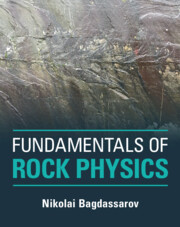Book contents
- Fundamentals of Rock Physics
- Fundamentals of Rock Physics
- Copyright page
- Dedication
- Contents
- Preface
- 1 Introduction
- 2 Density and Porosity
- 3 Stresses in Rocks
- 4 Mechanical Strain and Elastic Moduli
- 5 Permeability of Rocks
- 6 Mechanical Properties of Fluid-Bearing Rocks
- 7 Acoustic Properties of Rocks
- 8 Electric Resistivity
- 9 Dielectric Properties
- 10 Magnetic Properties of Rocks
- 11 Thermal Properties of Rocks and Minerals
- 12 Radioactive Properties of Rocks
- Index
- References
3 - Stresses in Rocks
Published online by Cambridge University Press: 19 November 2021
- Fundamentals of Rock Physics
- Fundamentals of Rock Physics
- Copyright page
- Dedication
- Contents
- Preface
- 1 Introduction
- 2 Density and Porosity
- 3 Stresses in Rocks
- 4 Mechanical Strain and Elastic Moduli
- 5 Permeability of Rocks
- 6 Mechanical Properties of Fluid-Bearing Rocks
- 7 Acoustic Properties of Rocks
- 8 Electric Resistivity
- 9 Dielectric Properties
- 10 Magnetic Properties of Rocks
- 11 Thermal Properties of Rocks and Minerals
- 12 Radioactive Properties of Rocks
- Index
- References
Summary
Scales of rock heterogeneity are nano≪micro ≪ meso ≪ macro. In order to estimate effective physical parameters by using an averaging procedure over a certain representative reference volume, estimations of effective physical parameters may be done by taking the Reuss or the Voigt mean values or using the upper and lower Hashin–Shtrikman bounds. The fracture number per unit length of a rock is correlated with the rock quality or RQD index. Autorun analysis of rock fractures in scanlines yields a consistent criterion of rock quality. The stress tensor is defined in a symmetric matrix. In diagonal form, the elements of the stress matrix are principal normal stresses. The Mohr’s circle in 2D and 3D is used to define normal and tangential stress in an arbitrarily oriented plane. The strength of rocks depends on modes of deformation according to the failure criteria after Mohr-Coulomb, Griffith, and Hoek and Brown. The ISRM standard and four point bending tests of rock strength are designed to determine yield strength. Fracturing and failure modes in rocks are considered according to tensile fracture models after Griffith, Dugdale, Barenblatt and critical tip opening displacement. Focus Box 3.1: Percolation models in rocks.
Keywords
- Type
- Chapter
- Information
- Fundamentals of Rock Physics , pp. 66 - 112Publisher: Cambridge University PressPrint publication year: 2021

